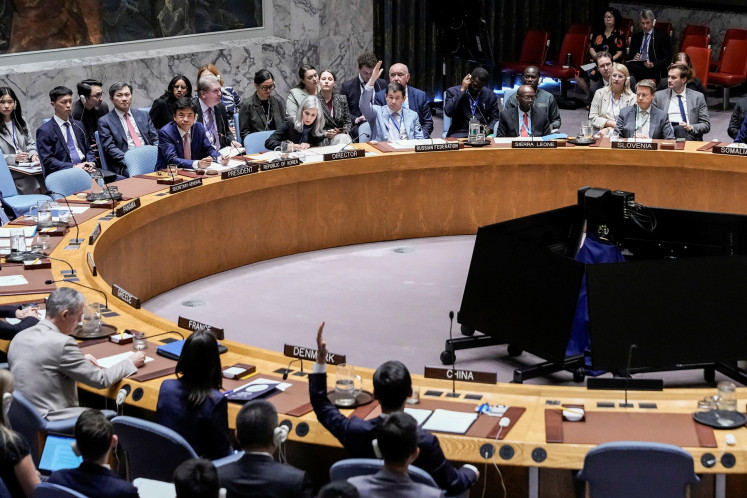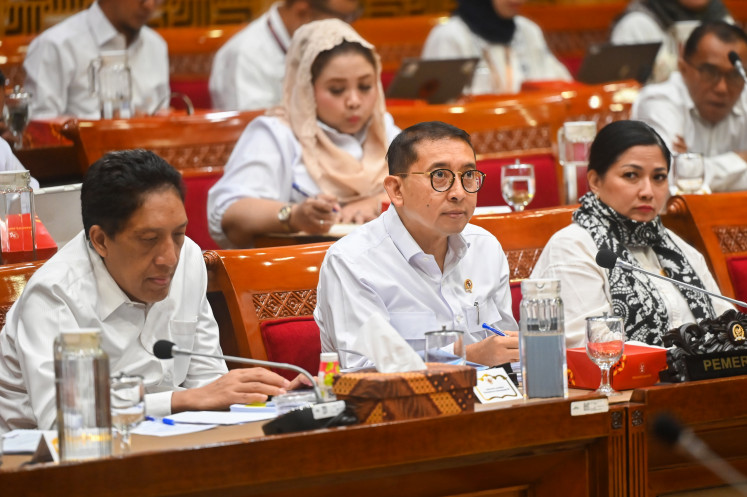Popular Reads
Top Results
Can't find what you're looking for?
View all search resultsPopular Reads
Top Results
Can't find what you're looking for?
View all search resultsDolphin circuses persist despite government assurances
On fire: A dolphin at one of the traveling circuses is trained to jump through a ring of fire for a paying audience
Change text size
Gift Premium Articles
to Anyone
On fire: A dolphin at one of the traveling circuses is trained to jump through a ring of fire for a paying audience.
Conservation groups have become increasingly frustrated with a perceived lack of action by the government, which agreed more than two years ago to rescue illegally held dolphins from traveling circuses.
But at a public discussion last Tuesday, they were given some hope when Forestry Minister Zulkifli Hasan went on the record to say traveling circuses were illegal, that he would close them down and called on NGOs for support.
Indonesia is home to the world’s last remaining traveling dolphin circuses. The intelligent sea mammals are trained to jump through rings of fire, are hauled from town to town under poor conditions and the high levels of chlorine in their shallow plastic pools can cause blindness and burn their skin. Many die due to stress, chlorine toxicity and lack of proper care.
Circus advertisements show the dolphins perform up to seven times a day alongside a baby bear, two otters and cockatoos.
Traveling: Dolphins are expected to perform up to seven times a day alongside a baby bear, two otters and cockatoos. They are hauled from town to town in the back of a truck, often with other animals.
On the move: Dolphins are kept in shallow plastic pools where high levels of chlorine can cause blindness, burn their skin or cause death through poisoning.
When the Jakarta Aid Animal Network (JAAN) heard about a dolphin dying during a performance in 2009, they approached the government, who then asked JAAN for help. The government told JAAN that the circus wanted to release their surplus dolphins but didn’t have the skills, money and knowledge to do so, JAAN founder Femke den Haas said.
In 2010, a memorandum of understanding (MoU) was signed between the ministry’s then conservation director Harry Santoso and JAAN to work together in a five-year-plan to “confiscate, rehabilitate and release” captive dolphins.
In accordance with the MoU, NGOs bought microchips for the 72 captive dolphins to help avoid trafficking and put between US$150,000 and $200,000 into building the largest dolphin rehabilitation center in the world.
Located at Karimunjawa, it is situated in a national park where the dolphins were allegedly originally captured, and was supposed to start receiving the animals in March 2011.
But nearly two years later and 27 months after the MoU was signed, no dolphins have been micro-chipped, none have been released for rehabilitation and the center remains empty.
Den Haas said while the sea pen was being built there was a change in conservation director to Bambang Novianto. On the day of the planned operation to transfer the dolphins to the sea pen, government officials canceled the effort just one hour before it was scheduled to begin.
Dolphin Project founder and Earth Island Institute dolphin activist Richard O’Barry said he agreed to participate three years ago, to work alongside JAAN, when he was assured there was full government cooperation.
He said since then their efforts to free the dolphins have been obstructed and the captive dolphin industry in Indonesia appeared to yield influence over the government.
“It seems as though the current minister has never seen the MoU,” he said. “It seems to be that there are a lot of people below him keeping information from him. JAAN has written him 20 formal letters, an email and a fax, none of them were ever answered.”
When Zulkifli was asked why the rehabilitation center was still empty, he said he had not heard of the center before, despite it being a main priority in the MoU. He said that was JAAN’s work and not that of the ministry.
In June 2011, the government announced it would release three of the 72 captive dolphins directly back into the ocean. According to den Haas, without assisted rehabilitation, the dolphins would die. To this date, none have been released.
The minister confirmed that there are three dolphin shows, all of which were not traveling, and that they had permits. They are Taman Safari Indonesia Zoo in Bogor, Taman Impian Ancol Park in Jakarta and Central Java-based PT Wersut Seguni Indonesia in Kendal, which were all “really strictly regulated”.
He said traveling circuses are illegal and that his ministry had a “zero tolerance” policy toward them. The ministry would use special police, their own power of investigation and allow the case to go through the justice system to shut them down, but they also needed the cooperation of local and provincial governments, he said.
“The best thing for the public to do is to inform the ministry directly, not through the media or social websites, so we can take direct action,” he added.
According to JAAN, the three companies with permits also organized traveling shows, with Wersut Seguni Indonesia having three different shows and holding up to 30 dolphins despite having legal permits for just six.
Dolphin circuses are considered conservation or educational institutions and the Forestry Ministry issues permits accordingly under biodiversity rule no.5/1999.
Traveling circuses have claimed they have rescued the dolphins, which allows them to bypass government regulations and receive temporary permits.
Den Haas said JAAN had proof that the dolphins had not been rescued from being entangled in fishing nets as circuses had claimed, but were instead captured.
She said the fishermen who supplied the dolphins admitted on tape that they were given equipment and money to catch them by the dolphin circus industry.
At the discussion last Tuesday, Zulkifli received a question from an audience member who said he had seen a dolphin performance at a circus in Bantul, Yogyakarta, and had been told by circus officials that they had obtained the permit from the Forestry Ministry.
“You just tell me where the circus is, and if need be, I will go there myself and shut it down,” the minister responded.
On Friday in an interview with The Jakarta Post, when told that the traveling circus was currently in Cirebon and asked whether he would go, Zulkifli said he “would look into it”.
Den Haas said they wanted to get dolphins into the sea pen, rehabilitate them and get the message out to the world that the process has begun. After rehabilitation, the dolphins would be released in the Karimunjawa area.
“We have been patiently waiting for two years now,” she said.
Den Haas and O’Barry have received a considerable backlash because of their work. Both were key speakers at the discussion on Tuesday night where O’Barry wore a bulletproof vest as people associated with the dolphin industry protested outside and members of JAAN had received death threats.
No rehab: Richard O’Barry stands by the dolphin rehabilitation sea pen in Karimunjawa, which has been empty but open for two years. There dolphins would be retrained how to use their sonar capabilities and how to catch fish, and eventually be released in the national park from where they were allegedly captured.
O’Barry said they would not back down, and if they allowed the opposition to intimidate them it would not only affect dolphins, but also tigers, orangutans, rhinos and all the other animal protection programs on the table.
“We will wait forever. We are not giving up. We are here to respond to his request — he requested publicly for NGOs to come and help. Okay, we’re here, we’re ready to go,” O’Barry said.
“[The minister] is the one who said he was going to go down to the traveling show with me. I’m still waiting to hear from him.”
— Photos Courtesy Of Kate Tomlison, Dolphinproject.Org













